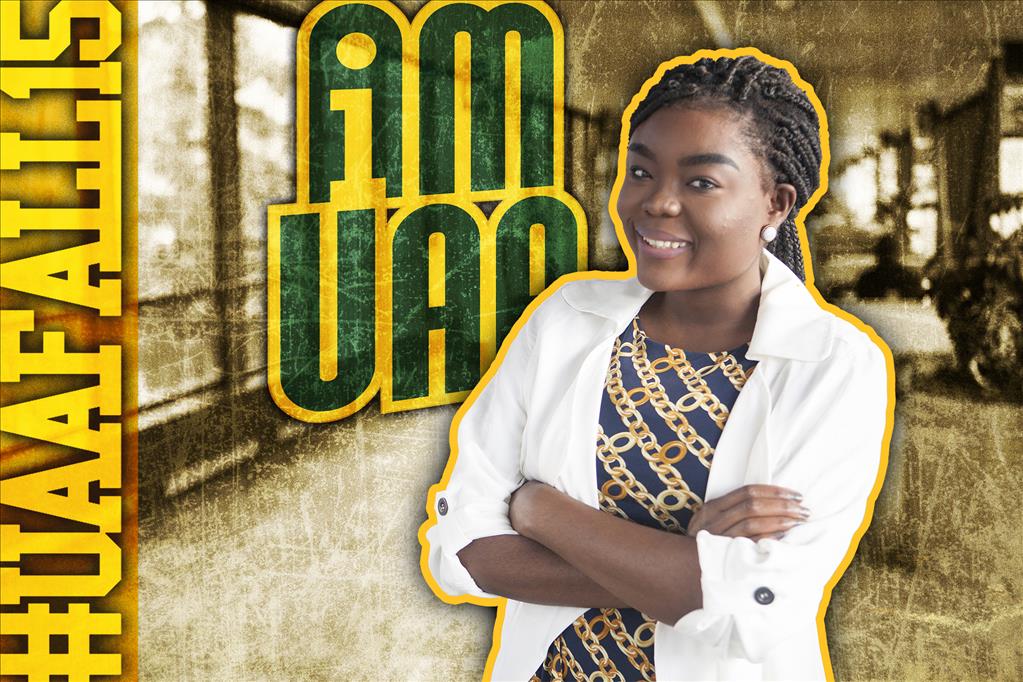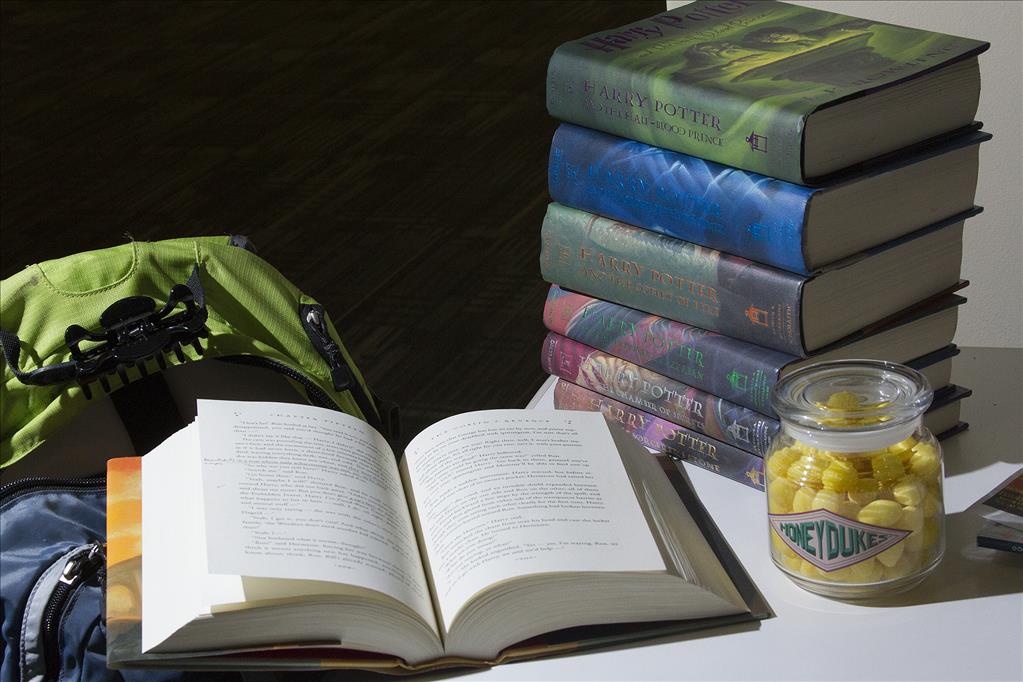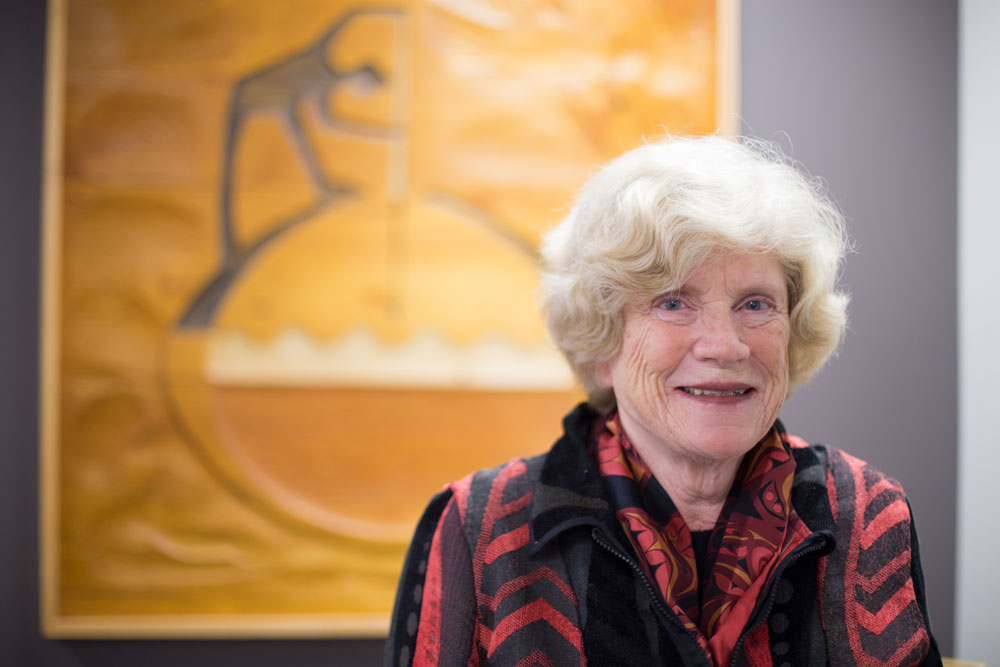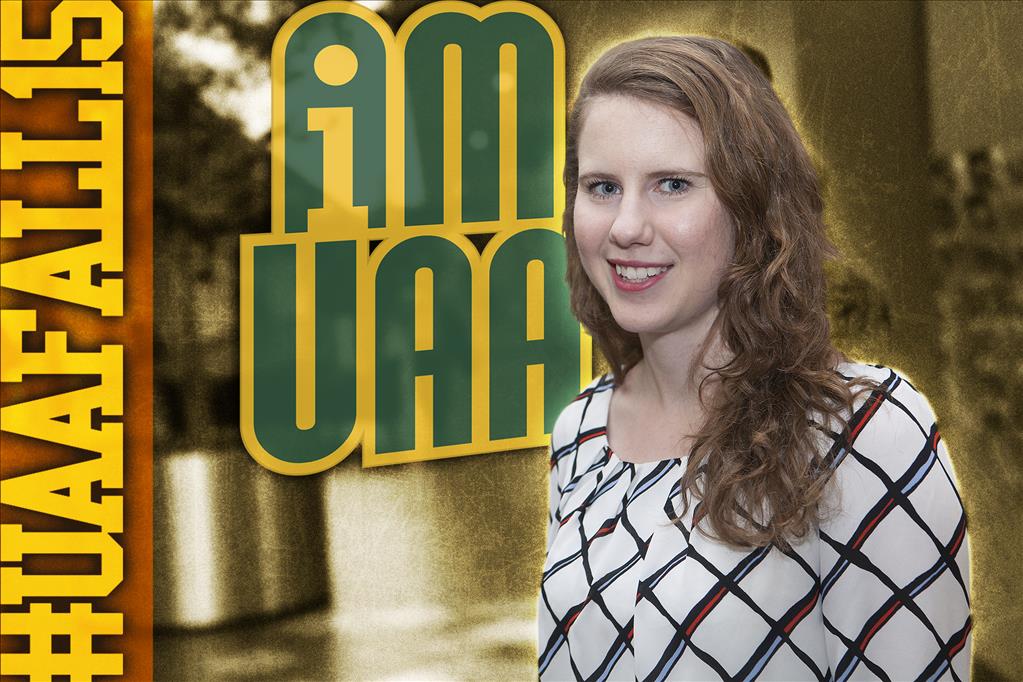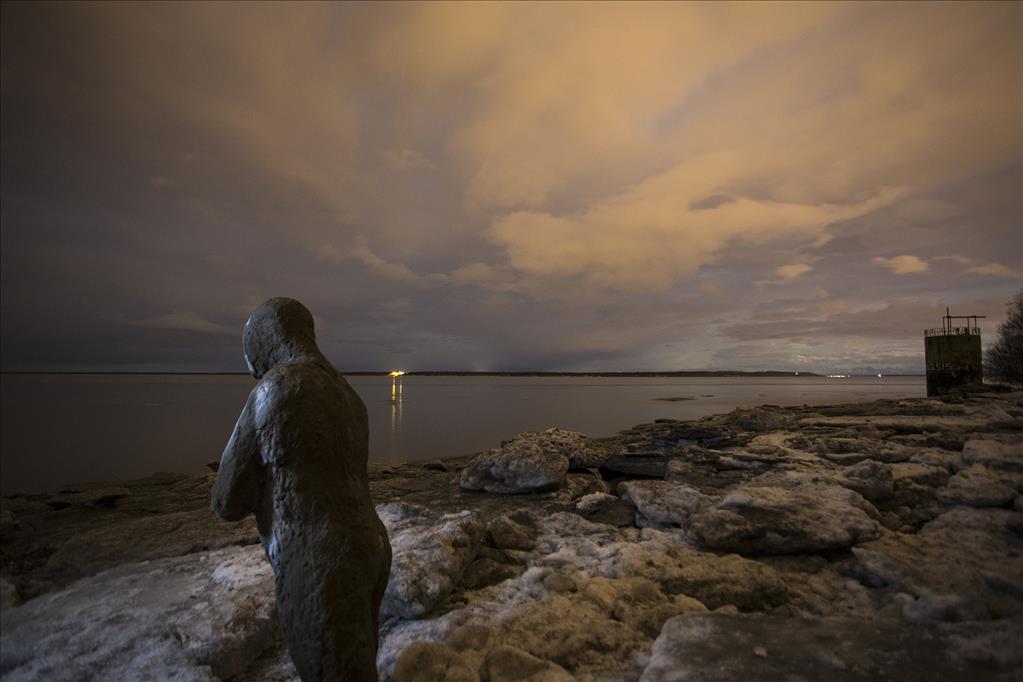An Ice Age American Lion comes home to perch in the UAA Geology Rock Garden
by Kathleen McCoy |
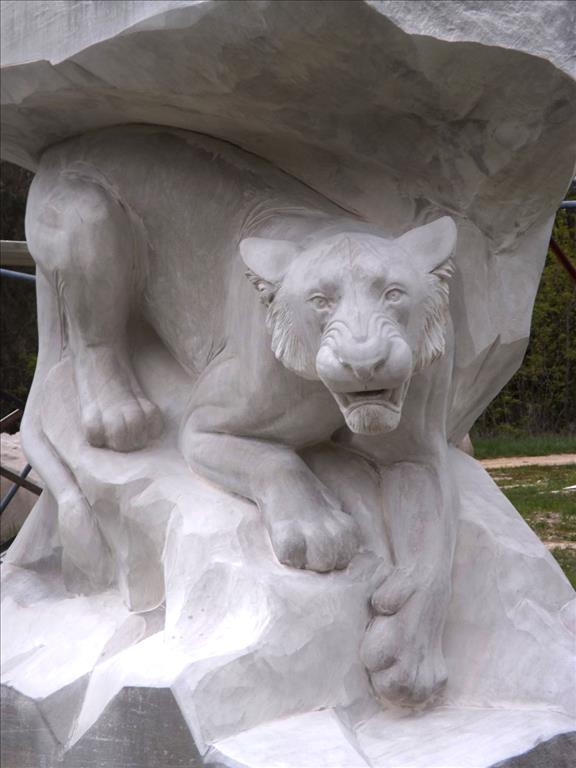
The American Lion is the largest cat that has ever lived. African lions are three feet tall at the shoulder. The American Lion is four feet tall at the shoulder. (Photo courtesy of artist Meg White)
Don't be alarmed if you hear that a ginormous American Lion was spotted on UAA's campus this week.
Oh, those rumors are true, all right. This beast is full of life and ready to pounce, but it's also frozen in place, carved from a beautiful 40,000-pound block of Indiana limestone hand picked by the artist.
This Pleistocene epoch creature (0.34 million to 11,000 years ago) will perch on a ledge in the UAA Geology Rock Garden. Weighing in at a trim 26,000 pounds, the carving is a Percent for Art addition to campus made possible by the remodeling of the Science Building (SCI).
As you'll note when you nose around campus looking for the lion, most of the rock garden has been relocated from the south and east side of Beatrice McDonald Hall (BMH) to the east side of the renovated Science Building. SCI is home to Physics, Astronomy, Geology, Math, Biology and Liberal Studies science labs, research labs and offices.
The lion is a special campus addition. Members of the art search committee began their endeavor back in 2011, working with the Alaska State Council on the Arts. According to working notes, they sought a non-abstract artwork that would draw passersby into the UAA Geology Rock Garden. They also expressed interest in an Ice Age animal, old enough to have been around when glaciers covered Anchorage and dropped erratics here transported from higher elevations in Talkeetna and the Chugach Mountains. Other rocks and petrified wood in the garden are much older, millions of years older. A tour of the garden includes great signage that identifies and ages and types of geologic features.
The pitch to artists went out in 2013 and 183 responded; eight were shortlisted.
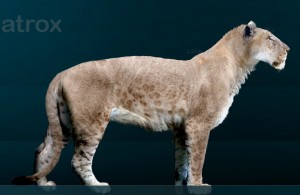
Panthera leo atrox Sergiodlarosa" by Sergiodlarosa. Licensed under CC BY-SA 3.0 via Wikimedia Commons
Sculptor Meg White, a finalist, proposed an American Lion. The committee, thinking the lion was not native to Alaska, asked instead for a Saber Tooth Tiger. White concurred, only to find that no teeth or bones of the Saber Tooth have ever been found in Alaska.
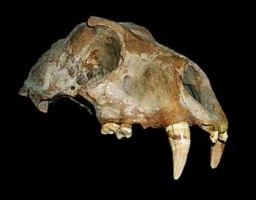
This American Lion skull was found in interior Alaska in 1995. It is carbon dated to 19,250 yars old.
Rather, experts at the UA Museum of the North in Fairbanks recommended a return to the American Lion. A skull of one of these lions was indeed found in the interior of Alaska, in 1995, by a Wasilla youth, Devon Foster. It was carbon dated at 19,250 years old. American Lion skulls are on display both at the Fairbanks museum and at the Alaska Museum of Science and Nature in Anchorage.
So how DO you carve a stone lion?
Artist Meg White, 51, works out of her home in rural Kentucky, which happens to be just 100 miles from her common source material, limestone quarries in Bedford and Bloomington, Indiana. In addition to bronze work and human figures, she is known for her wildlife carvings

Portrait of the artist, Meg White, at work. She is sculpting Ely, a baby elephant. (Photo courtesy of Meg White)
Examples include a cougar, a panther, elephants, even a family of hippos for a zoo in North Carolina. She pulls these animated figures from stone with skillful use of power tools.
Power tools? Isn't that dangerous? Not to mention heavy and hard?
All of the above is true, White will tell you. The whirring blades have diamond tips. The tool can weigh up to 10 pounds. When actively carving and blocking, she can manage only about six hours of work at a time, with a break every 60-90 minutes. Since detail work is less physically demanding, she can go longer at that stage. This project took eight months, plus extra days here and there for tweaking and finishing.
Her work day starts about 11 a.m., and goes until nightfall, which in Kentucky in summer is about 9 p.m. She does all her work outdoors. A big reason is the natural light this approach affords.
"As the light moves across a piece, you see how shadows change," White says. "You see things differently."
She can't work in rain. But what if it's 90 degrees and blazing sun outside? Still a go. "I try to work on the shady side of the sculpture for awhile," she says, optimistically.
Some don't find it 'women's work'
I wondered if she took any guff for being a woman sculpting with power tools.
Oh, yes, she confirmed. "I am not believed, because I am a woman." In fact, she could only name two or three other women who sculpt with power.
She recalled one of her commissions in a public setting, cutting on a giant foot with a big grinder. All the guys standing around watching her work were skeptics: "They were saying 'you're gonna die,' 'this is going to kill you.'"
But White says she has deep respect for the big tools, and has run them safely since 1997. A few years before that, she'd begun watching and following the work of fellow Kentucky artist, Don Lawler, who'd traveled to Italy and learned the power-tool techniques. ("No hammers and chisels," White says. "That's a big misconception people still have.")
It's hard to imagine, but White came to stone from three-dimensional paper sculpture. She is a self-taught artist who found that, as a kid, she could make anything out of clay. She was doing commercial work and 3-D paper sculpture when the chance to apprentice with Lawler set her on a new course. She fell in love with the challenges. Stone weighs 150 pounds a cubic foot. "It gets heavy quick," she said.
Here, on her blog "Rock, Paper Scissors N Clay" (If It Isn't An Ordeal, It Isn't Fun...), you can watch White wrestle with individual details on her American Lion sculpture.
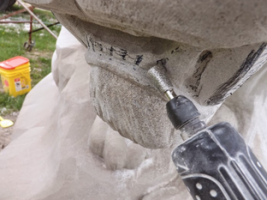
A diamond burr on the grinder flares out just enough to create space between the teeth. (Photo courtesy Meg White)
To cut the lion's small lower teeth, she uses a diamond burr on the die grinder, because "the burr flares out at the end which is better for cutting in between the teeth." She finds she has to "soften the lips" and bring the canine teeth closer and "more to a point." She even climbs up on top of the sculpture to create a path for rainwater down the stone and away from the lion's front leg.
Much to our benefit, she videotapes herself at work. In this 2-minute You Tube clip, called "lion cut side," you can watch her trimming away excess stone from beneath the lion's chin, using deep vertical cuts that she taps away with an engineer's hammer.
That's one end of her work spectrum. For another, check out this 2-minute plus time lapse of her carving the entire UAA lion, when she goes literally from the stone block to the crouching beast.
Don't try this at home
White said the hardest part of the UAA lion was carving the stone out between the lion's head and the ledge roof. "You have to reach out, holding up the tool," she said. "My arms were killing me."
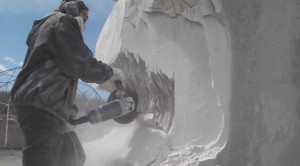
Screenshot from video showing artist Meg White grinding away stone beneath the American Lion's jaw. (Video courtesy Meg White)
The challenge is holding sharp, whirring wheels very straight as you cut into the stone, she said. If you don't, the tool binds up on the rock and then kicks back with force.
So, then there was this accident. A little one. She was working on the lion's back foot, using a four-inch turbo blade when it misbehaved. "It bound up and kicked back," White said. "It hit me right in the forehead. That scared me. It's the worst thing that can happen."
Fortunately, her protective gear took the brunt of the kick, but she still sustained a cut. "I've got a scar," she said. Fortunately, it didn't widen and didn't need any stitches.
On campus this week
White and I spoke by phone on Friday, July 17. The lion was already on a truck bound for Alaska.
"You must be relieved" that it's done, I suggested
There was a pause on the line.
Then, "I will feel great once it's installed. That's a lot of weight; you worry about all the things that can happen. So it's scary right until it's on its concrete base and everything is OK. Then, I'll breathe a sigh of relief."
Flash forward to about noon on Thursday, July 23. After a 4,000 mile trip up the Al-Can, an overnight in a motel parking lot in Eagle River, plus an inspection for any damage that might have happened despite a canvas cover during the long journey, the Ice Age lion lay on a flatbed truck on a campus side street, its nose pointing up into a soft morning rain. Home at last.
Now, a 2-man crew and a 50,000-pound rig from Alaska Crane had some heavy lifting to do. Austin Schimschat worked the cab while Robert Moon guided from the ground. There were delicate moments-tipping the structure up on one end and then gently settling it back down. And then the big climax, the moment the big cat nestled into its concrete bed. Hovering just inches above the ground, two round bars extruding from the sculpture's flat bottom were aimed at holes in the concrete -- like threading a needle. As the statue settled gently in, Meg White beamed broadly and gave Austin and Robert a thumb's up. Don Lawler, who had traveled with Meg White to help with the installation, said later the Alaska Crane work was the best he'd ever seen. He and Meg together have more than two dozen installations around the country. This is a critical moment, and they've seen it go badly. But not this time.
The campus community officially welcomes the cat on Friday, July 24. .Stop by for a piece of cake and the chance to chat with Meg White between 11:30 and 1 p.m.
For her part, Meg White is determined to see a bit of Alaska before she heads home to Kentucky. On her list: the Chugach mountains, the Russian River, and maybe even Katmai, "for the bears."
The chance to install her work in Alaska clinched the opportunity for her. That, and its new home in the Geology Rock Garden right next to the renovated Science Building.
"I felt like my work really suited this commission," she said.
Written by Kathleen McCoy, UAA Office of University Advancement
 "An Ice Age American Lion comes home to perch in the UAA Geology Rock Garden" is licensed under a Creative Commons Attribution-NonCommercial 4.0 International License.
"An Ice Age American Lion comes home to perch in the UAA Geology Rock Garden" is licensed under a Creative Commons Attribution-NonCommercial 4.0 International License.










